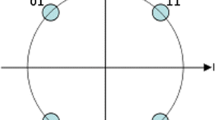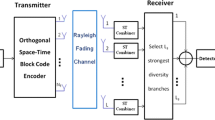Abstract
In MIMO systems, space-time block code (STBC) is good solution for improving system performance. Among the STBCs, coordinate interleaved orthogonal designs (CIODs) combined with QR-decomposition-based decision-feedback decoding (QR-DDF) allow achieving good performance for time-selective fading channels. However, half of entries in codeword matrix of CIODs are zeros. These zero entries result in high peak-to-average power ratio (PAPR) and also impose a severe constraint on hardware implementation of the code when turning off some of the transmitting antennas whenever a zero is transmitted. In this paper, we propose a new design of space-time block codes without zero entry in codeword matrix (NZE-STBCs) for time-selective fading channels. The main advantage of the proposed NZE-STBCs is that its peak-to-average ratio (PAPR) is 3 dB lower than that of CIODs, and its hardware implementation is also easier due to eliminating on-off switchers without sacrificing performance. Moreover, similar as CIODs, the proposed NZE-STBCs can use low complexity QR-DDF decoder over time-selective fading channels to enhance performance and reduce decoding complexity. Simulation results show that the proposed NZE-STBCs outperform CIODs for three transmit antennas while performing the same for two and four transmit antennas.



Similar content being viewed by others
References
Tarokh, V., Seshadri, N., & Calderbank, A. R. (1998). Space-time codes for high data rate wireless communication: performance criterion and code construction. IEEE Transaction on Information Theory, 44, 744–765.
Alamouti, S. M. (1998). A simple transmit diversity technique for wireless communications. IEEE Journal on Selected Areas in Communications, 16, 1451–1458.
Tarokh, V., Jafarkhani, H., & Calderbank, A. R. (1999). Space-time block codes from orthogonal designs. IEEE Transaction on Information Theory, 45, 1456–1467.
Jafarkhani, H. (2001). A quasi-orthogonal space-time block codes. IEEE Transaction on Communication, 49, 1–4.
Tirkkonen, O., Boariu, A., & Hottinen, A. (2000). Minimal non-orthogonality rate 1 space-time block code for 3-Tx antennas. In Proceedings of IEEE interntional symposium spread spectrum techniques and applications (ISSSTA’00) (pp. 429–432). NJ, Sep. 6–8, 2000
Papadias, C. B., & Foschini, G. J. (Mar. 2003). Capacity-approaching space-time codes for systems employing four transmitter antennas. IEEE Transaction on Information Theory, 49, 726–732.
Sharma, N., & Papadias, C. B. (Mar. 2003). Improved quasi-orthogonal codes through constellation rotation. IEEE Transaction on Communications, 51, 332–335.
Su, W., & Xia, X.-G. (Oct. 2004). Signal constellations for quasi-orthogonal space-time block codes with full diversity. IEEE Transaction on Information Theory, 50, 2331–2347.
Khan, M. Z. A., & Rajan, B. S. (2002). Space-time block codes from co-ordinate interleaved orthogonal designs. In Proceedings of IEEE international symposium on information theory (ISIT). Lausanne, Switzerland :
Khan, M. Z. A., & Rajan, B. S. (2006). Single-symbol maximum-likelihood decodable linear STBCs. IEEE Transactions on Information Theory, 52(5), 2062–2091.
Yuen, C., Guan, Y. L., & Tjhung, T. T. (2008). Power-balanced orthogonal space-time block code. IEEE Transactions on Vehicular Technology, 57(5), 3304–3309.
Yuen, C., Guan, Y. L., & Tjhung, T. T. (2005). Quasi-orthogonal STBC with minimum decoding complexity. IEEE Transactions on Wireless Communications, 4(5), 2089–2094.
Wang, H., Wang, D., & Xia, X. G. (2009). On optimal quasi-orthogonal space-time block codes with minimum decoding complexity. IEEE Transactions on Information Theory, 55(3), 1104–1130.
Sinnokrot, M. O., & Barry, J. R. (2009). A single-symbol-decodable space-time block code with full rate and low peak-to-average power ratio. IEEE Transactions on Wireless Communications, 8(5), 2242–2246.
Lee, H.-J. (Dec. 2007). Wireless systems incorporating full-diversity single-symbol decodable space-time block codes: Performance evaluations and developments. In Doctor Dissertation. The University of Texas, Austin
Jakes, W. C. (1974). Microwave mobile communication. New York: Wiley.
Dayal, P., & Varanasi, M. K. (May 2005). Maximal diversity algebraic space-time codes with low peak-to-mean power ratio. IEEE Transactions on Information Theory, 51(5), 1691–1708.
Author information
Authors and Affiliations
Corresponding author
Rights and permissions
About this article
Cite this article
Pham, VB., Sheng, WX. No-Zero-Entry Space-Time Block Codes Over Time-Selective Fading Channels for MIMO Systems. Wireless Pers Commun 75, 35–47 (2014). https://doi.org/10.1007/s11277-013-1339-x
Published:
Issue Date:
DOI: https://doi.org/10.1007/s11277-013-1339-x




